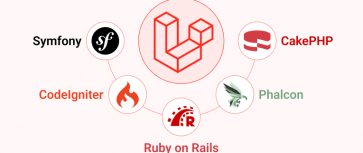A Complete Guide to Laravel Caching
To obtain great performance and scalability, Laravel caching is crucial. If you want to avoid slow APIs and page loads, adopt the suitable caching strategy from the start of development. If you want to improve your users’ experience and your company’s bottom line, you need to deploy the best Laravel caching strategy possible, as Laravel is among the most widely used PHP frameworks.
This article delves into techniques for configuring and implementing caching in Laravel before you hire Laravel developers from India or across the globe. You will get an understanding of popular Laravel caching, as well as many caching methods, queries and how to manage cache in Laravel web applications.
1. Why is Caching Important?

To ensure that your views and events are already assembled and ready to go whenever your Laravel application receives a request, you can use the two additional commands that Laravel provides to save past events and views in a cache.
According to research conducted online, “Every second of delay in page loading costs Amazon $1.6 billion in annual sales.” The outcomes from the additional Google study said, “Our analysis suggests that if search results are delayed by even a millisecond, user search less” This impatience isn’t unique to the search process, though. Approximately 80% of viewers will abandon a video that takes too long to load. Even a fraction of a second delay in your website’s page loading may have a devastating effect on your visitors and bottom line.
2. What is Laravel Caching?
Caching data in the Laravel PHP framework is a strong functionality for increasing the speed and reliability of your Laravel applications. Laravel makes it simple to set up and swap between different cache engines without having to write any code.
Laravel allows you to manage all of your programs’ entire cache settings from a single configuration file. In addition, Laravel offers a unified API for interfacing with different caching backends and includes all popular caching backends out of the box, including Memcached and Redis.
One of the best things about Laravel caching is that it automatically caches Blade templates, which are the views your application uses to create HTML pages. Laravel uses only PHP and HTML to convert Blade templates into a form that can be cached and reused for repeated requests. In general, Laravel caching is a must-have for any PHP framework serious about speed.
2.1 Benefits of Using Laravel Cache
The Laravel cache is a robust caching mechanism that may improve your web application in many ways. Using Laravel cache has several advantages, like these:
- Enhanced Efficiency
Laravel cache decreases data retrieval time through the database and external APIs, boosting the application’s speed. Specifically at peak times, this means less strain on web servers and a smoother experience for users. In addition, Laravel cache allows you to quickly and simply swap between different caching engines.
- Reduced Database Load
By keeping regularly visited data in the cache, caching helps to alleviate strain on your database server. As a result, fewer database queries are run, and the system’s whole performance is enhanced, as there is no longer the requirement to continually obtain data from the database.
- Flexibility
Laravel cache gives you options, letting you pick between file-based, database-based, and Redis cache among others. Considerations including data type, size, and predicted traffic can help you choose which caching approach is ideal for your Laravel application. It is simple to configure and manage Laravel’s cache due to its user-friendly interface.
Now that you understand what Laravel caching is and why it’s useful, let’s have a look at Laravel Cache Drivers.
3. Laravel Cache Drivers and Comparisons
Excellent caching backends and drivers are available with Laravel cache. You can choose one or the other to optimize application speed and load time based on your specific needs. However, if none of the options below suit your needs, Laravel cache also provides a straightforward method to build a bespoke backend and utilize it with Laravel cache.
Next, we’ll discuss the various Laravel cache backends available.
3.1 File
If no other drivers are provided in the .env file, Laravel will utilize the file driver as its cache backend.
Laravel encrypts and saves the cached information in a file in the storage/framework/directory, as per the architecture of the file backend. When fresh data is cached, Laravel encrypts both the data and the cache key and stores them in a separate file. The same thing occurs when the user attempts to retrieve data. If the cached item with the given cache key exists in the provided folder, Laravel will return it.
The file backend is not only ideal for development but also for saving time during the setup of third-party drivers. In comparison to going straight to the database server, this method is much quicker.
The preceding command should be present in your .env file in order to function with the file driver:
CACHE_DRIVER=file
3.2 Array Cache Driver
The array cache driver is a simple caching backend that works well with GitHub Actions, Jenkins, etc. for executing automated tests.
PHP’s array backend handles caching information, and it does not necessitate the installation or configuration of any drivers. The performance of the application is somewhat better than the file cache backend, and it works nicely for automated testing.
The preceding command should be present in your .env file in order to utilize the array driver:
CACHE_DRIVER=array
3.3 Database
Data retrieved via the database driver is kept in memory for the duration of the currently running PHP session. As a result, you’ll need to make a table in your database to keep the cached information. By dividing the burden of queries from the backend and dispersing it over numerous frontends, database caching also increases scalability.
To automatically construct the database schema required by the database driver, you can execute this Artisan command— php artisan cache:table. When any program may be installed on your hosting platform, you’ll want to utilize the database driver.
Take the case of utilizing a free, feature-restricted hosting service as an illustration. Since the database driver is typically the web application’s weakest link, we advise against forcing additional data through it and instead recommend that you continue with the file driver.
The preceding command should be present in your.env file in order to utilize the database driver:
CACHE_DRIVER=database
3.4 Redis
The redis driver takes advantage of Redis, a memory-based caching system. It’s fast compared to the remaining cache drivers we looked at, but it needs you to set up and manage additional hardware.
The preceding command should be present in your .env file in order to utilize the redis driver:
CACHE_DRIVER=redis
3.5 Memcached
Memcached is widely regarded as the best memory-based cache-store available today. it is a wonderful alternative for memory-based cache drivers if you are okay with a little more server management (installing and maintaining additional services).
The Memcached PECL package is required for use with the Memcached driver.
The following command should be present in your.env file in order to utilize the Memcached driver.
CACHE_DRIVER=memcached
Your project’s use case and data retrieval needs will determine the optimal caching driver to employ and the cache driver’s effectiveness.
4. Laravel Cache Usage and Methods
You must use the Illuminate\Contracts\CacheFactory and Illuminate\Contracts\CacheRepository packages to connect to the Laravel caching services before you can utilize them.
The Factory contract provides accessibility to all of the application’s cache drivers. You implement the default cache driver for the web application you are developing in the repository contract.
Among the many functions of Laravel Cache are:
- Cache::Put ()
- Cache::Get()
- Cache::Forever()
- Cache::Has()
4.1 Store Cache
Cache::Put() requires three parameter keys, value, and time in minutes — to cache all data from the application. You may use the following code in your routes for testing:
Cache::put(key, value , 30);
When you require access to certain information stored in a cache, you may utilize the key to do so. You can use the remember() function to speed up and simplify the procedure of refreshing the cache. This procedure initially verifies the Cache key, and then delivers the actual outcome if it is present. If not, it makes a new key that includes the value. See whether the subsequent code works:
Cache::remember('articles', 30, function() {
return Article::all();
});
The specified value of ’30’ indicates the overall duration of minutes of data to be stored in the cache. With this, you may avoid constantly monitoring the cache. As an alternative, Laravel will always automatically get the cache without any intervention from you.
4.2 Cache Retrieve
The Get() function can be utilized for recovering earlier stored data. To implement this in your routes file, simply copy and paste the following:
Route::get('/', function() {
return Cache::get( 'key' );
});
4.3 Incrementing / Decrementing Values
You can use the increment and decrement operators to modify the values of cache integer objects. You can optionally specify an increment or decrement value as a parameter to either of these actions.
Cache::increment('key');
Cache::increment('key', $amount);
Cache::decrement('key');
Cache::decrement('key', $amount);
4.4 Existence Cache:: Has()
Has() is outlined below and can be used to determine if the key exists prior to data retrieval:
Route::get('/', function() {
if (Cache::has('key')){
Cache::get('key');
} else {
Cache::put('key', $values, 30);
}
});
4.5 Remove Cache Value
Below is an example of using the forget() method to delete Laravel’s cache:
Cache::forget('key');
In addition to retrieving cached data, you can quickly discard it. One-time caching describes this technique well.
$articles = Cache::pull('key');
4.6 Clear Laravel Cache
You can clear Laravel’s cache at any time, not just when it’s about to expire, using the following command line:
php artisan cache:clear
4.7 Clear Route Cache
The following terminal command will remove the route cache for your Laravel application:
php artisan route:cache
4.8 Clear Config Cache
Run the following command in the terminal to delete the Laravel application’s configuration cache:
php artisan config:cache
4.9 Clear Compiled View Files
The following terminal command will remove all built view files from your Laravel application:
php artisan view:clear
4.10 Database Cache
To use the Laravel database cache driver, you must create a table to store your cached data. The following is an example Schema declaration:
Schema::create('cache', function ($table) {
$table->string('key')->unique();
$table->text('value');
$table->integer('expiration');
});
5. Laravel’s Cache Commands
Laravel’s functionality necessitates starting the framework and parsing the routes file for every request. This necessitates reading the file, interpreting its data, and storing the data in a form that your program can work with. For this reason, Laravel includes a tool that generates a consolidated routes file for expedited processing:
php artisan route:cache
However, if you execute this command to alter your network’s route, you must also do this:
php artisan route:clear
To register your updated routes, you must first clear the cached routes file.
Laravel parses all of your project’s config files on every request, just like it does with route caching. As an alternative to manually dealing with each of these files, you may use the subsequent command to generate a single cached config file:
php artisan config:cache
You must execute the following program whenever your .env file or config files are modified, similar to the route caching described before.
php artisan config:clear
To ensure that your views and events are already assembled and ready to go whenever your Laravel application receives a request, Laravel provides two additional commands for doing so. The below commands can be used to save past events and views in a cache:
php artisan event:cache
php artisan view:cache
However, if you create an alteration to your code, you have to perform the accompanying instructions to “bust” the caches:
php artisan event:clear
php artisan view:clear
6. Laravel Caching Strategies
There are a variety of cache techniques to choose from, and the one that works best for your application will rely on its specific data structure and use case. You can tailor the plan specifically to your requirements, and here are the most common caching techniques that you can use in a Laravel application.
6.1 writeBack (writeBehind)
By imposing delays to the write procedures, this technique is a more complex implementation of the writeThrough strategy.
This technique is also known as the writeBehind approach because it introduces a temporal delay between the cache server and the database server.
The following code demonstrates how to employ this method with the Laravel cache.
$durationToFlush = 1; // (time in minute)
$tempToFlush = [];
public function writeBack($key, $data, $timeInMinutes){
return $this->writeThrough($key, $data, $timeInMinutes);
}
public function writeThrough($key, $data, $timeInMinutes) {
$cacheData = Cache::put($key, $data, $timeInMinutes);
$this->storeForUpdates($cacheData);
return $cacheData;
}
// This function stores new data to temp Array for updating
private function storeForUpdates($data){
$temp = {};
$temp['duration'] = this.getMinutesInMilli();
$temp['data'] = data;
array_push($tempToFlush, data);
}
// This function converts time in minutes to millisecond
private function getMinutesInMilli(){
$currentDate = now();
$futureDate = Carbon(Carbon::now()->timestamp + $this->durationToFlush * 60000)
return $futureDate->timestamp
}
// Calls to update the Database Server.
public function updateDatabaseServer(){
if($this->tempToFlush){
foreach($this->tempToFlush as $index => $obj){
if($obj->duration timestamp){
if(Database::create($obj->data)){
array_splice($this->tempToFlush, $index, 1);
}
}
}
}
}
Data is initially stored in the cache server and a temporary array before it is sent to the database server via the updateDatabaseServer function, which is called from the writeBack method.
6.2 Cache Aside (Lazy Loading)
To query the cache server directly, the program puts the database on hold. If the cache server finds a match, it sends the data back to the user. If the cache server cannot find a match, it queries the database server for the data and updates itself for future queries.
The following code demonstrates how to employ this method with the Laravel cache.
public function lazyLoadingStrategy($key, $timeInMinutes, $callback) {
if (Cache::has($key)) {
$data = Cache::get($key);
return $data;
} else {
// Database Server is called outside the Cache Server.
$data = $callback();
Cache::set($key, $data, $timeInMinutes);
return $data;
}
}
The preceding code demonstrates the use of the cache Aside Strategy, which is functionally similar to using the Cache::remember method.
6.3 writeAround
This method bypasses the cache server for all write operations and goes straight to the database server, modifying the cache server only on reads.
If a user initiates the creation of a new Article, the Article is saved in its entirety to the server-side database. You obtain an Article from the database server and then update it on the cache server when an individual first requests it.
The following code demonstrates how to employ this method with the Laravel cache.
public function writeAround($data) {
$storedData = Database::create($data);
return $storedData;
}
public function readOperation($key, $timeInMinutes){
$cacheData = Cache::remember($key, $timeInMinutes, function() {
return Article::all();
})
return $cacheData;
}
6.4 readThrough
Contrast this with the cache aside approach, which this is not. The cache server acts as an intermediary between the client’s query and the database server in this architecture.
The cache server receives all requests and travels to the database server to get the information if it is not already stored there.
The following code demonstrates how to employ this method with the Laravel cache.
public function readThrough($key, $timeInMinutes) {
$data = Cache::find($key, $timeInMinutes);
return $data;
}
private function find($key, $timeInMinutes){
if(Cache::has($key);){
return Cache::get($key);
}
// Database Server is called from the Cache Server.
$DBdata = Database::find($key);
Cache:put($key, $DBdata, $timeInMinutes);
return $DBdata;
}
So there you go! We’ve gone through some common Laravel caching techniques you may use in your next Laravel project. Keep in mind that you can use any caching approach you see fit for your project.
7. More Laravel Caching Strategies
As you can see, there are several application-specific considerations you should make before digging into caching.
7.1 Retrieving Data
How long do you intend to keep your data in the cache? Well, it depends on the data. Is there much variation in these figures? Or is there not much consistency? How crucial is it that we keep this data as current as possible whenever it’s requested? The answers to these inquiries will direct your choice on whether or not to cache the data and for how long.
7.2 Storing/Updating/Deleting Data
The term for this is “write caching.” It is more efficient to save the data in the cache and refresh it simultaneously rather than repeatedly accessing the database.
When deciding when to upgrade, more questions arise. What if there’s a system breakdown if you hang on for too long? There is now nothing left in the cache. What happens if someone asks about a product’s pricing but you’ve already updated the cache and they don’t see the new one? Because of inconsistencies in the data between the cache and the database, the user is not seeing the most up-to-date pricing information.
The requirements of your web application will determine the best method of write caching. Caching strategies include both write-back and write-through.
8. Best Practices for Maintaining and Updating Laravel Cache
Laravel Cache is an invaluable resource while it comes to enhance the speed of an app. To function at its best, you must maintain and update it on a regular basis, just like any other caching system.
Here are the best practices for improving your experience with Laravel Cache maintenance and updates:
- Select the Right Cache Driver: File, database, Redis, and Memcached are just some of the cache drivers available in Laravel. Your application’s demands and the server’s configuration will determine which cache driver is best for you to use. Applications with high traffic should use Redis or Memcached, while smaller apps can make use of the file cache driver.
- Monitor Cache Usage: Monitor cache utilization often to spot any problems. Check cache hits and misses, cache size, and cache lifespan with the use of tools like Laravel Telescope and Cache Monitor.
- Set Appropriate Cache Lifetime: Depending on the requirements of your program, choose a suitable cache lifespan. Keeping the cached data as up-to-date as possible requires a shorter cache lifespan, which might put more stress on the server. If the cache duration was increased then it’s possible to serve outdated data.
- Clear Cache Regularly: If you don’t want to offer out-of-date information, you should delete the cache on a regular basis. You may remove the cache manually with Laravel’s Artisan program or automatically with a cron job.
- Use Cache Tags: Tag cached objects so that they can be retrieved together. This makes it simple to clean only a subset of the cache rather than the full cache at once.
- Use the Latest Versions of Laravel and Cache: Updating your Laravel application and cache modules ensures that you have the most recent security enhancements and bug fixes. Your web app will be safe and run smoothly if you do this.
9. Summary
By creating a new project, running benchmarks on its answers, and then evaluating the results, we were able to investigate several approaches to manage and implement Laravel caching in this article!
We have provided many Laravel caching techniques. We also incorporated many caching techniques to enable you to select the one that best fits your needs. Happy caching!

Hardik Dhanani has a strong technical proficiency and domain expertise which comes by managing multiple development projects of clients from different demographics. Hardik helps clients gain added-advantage over compliance and technological trends. He is one of the core members of the technical analysis team.
The PHP programming language is considered to be one of the most popular worldwide, and this article will hopefully provide you with some useful tips...
 Aug 29, 2023
Aug 29, 2023 



Comments
Leave a message...